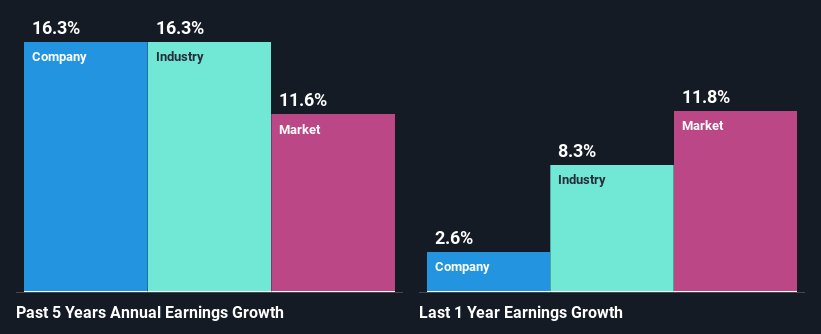- Japan
- /
- Electronic Equipment and Components
- /
- TSE:6861
Is Keyence Corporation's (TSE:6861) Stock's Recent Performance A Reflection Of Its Financial Health?

Keyence's (TSE:6861) stock up by 2.6% over the past week. Since the market usually pay for a company’s long-term financial health, we decided to study the company’s fundamentals to see if they could be influencing the market. Particularly, we will be paying attention to Keyence's ROE today.
Return on equity or ROE is a key measure used to assess how efficiently a company's management is utilizing the company's capital. Put another way, it reveals the company's success at turning shareholder investments into profits.
Check out our latest analysis for Keyence
How Do You Calculate Return On Equity?
The formula for ROE is:
Return on Equity = Net Profit (from continuing operations) ÷ Shareholders' Equity
So, based on the above formula, the ROE for Keyence is:
13% = JP¥378b ÷ JP¥2.9t (Based on the trailing twelve months to June 2024).
The 'return' is the amount earned after tax over the last twelve months. One way to conceptualize this is that for each ¥1 of shareholders' capital it has, the company made ¥0.13 in profit.
What Is The Relationship Between ROE And Earnings Growth?
Thus far, we have learned that ROE measures how efficiently a company is generating its profits. Depending on how much of these profits the company reinvests or "retains", and how effectively it does so, we are then able to assess a company’s earnings growth potential. Assuming all else is equal, companies that have both a higher return on equity and higher profit retention are usually the ones that have a higher growth rate when compared to companies that don't have the same features.
Keyence's Earnings Growth And 13% ROE
To begin with, Keyence seems to have a respectable ROE. Further, the company's ROE compares quite favorably to the industry average of 8.4%. This probably laid the ground for Keyence's moderate 16% net income growth seen over the past five years.
As a next step, we compared Keyence's net income growth with the industry and found that the company has a similar growth figure when compared with the industry average growth rate of 16% in the same period.

The basis for attaching value to a company is, to a great extent, tied to its earnings growth. It’s important for an investor to know whether the market has priced in the company's expected earnings growth (or decline). Doing so will help them establish if the stock's future looks promising or ominous. Is Keyence fairly valued compared to other companies? These 3 valuation measures might help you decide.
Is Keyence Making Efficient Use Of Its Profits?
In Keyence's case, its respectable earnings growth can probably be explained by its low three-year median payout ratio of 19% (or a retention ratio of 81%), which suggests that the company is investing most of its profits to grow its business.
Moreover, Keyence is determined to keep sharing its profits with shareholders which we infer from its long history of paying a dividend for at least ten years.
Conclusion
On the whole, we feel that Keyence's performance has been quite good. In particular, it's great to see that the company is investing heavily into its business and along with a high rate of return, that has resulted in a sizeable growth in its earnings. Having said that, the company's earnings growth is expected to slow down, as forecasted in the current analyst estimates. Are these analysts expectations based on the broad expectations for the industry, or on the company's fundamentals? Click here to be taken to our analyst's forecasts page for the company.
Valuation is complex, but we're here to simplify it.
Discover if Keyence might be undervalued or overvalued with our detailed analysis, featuring fair value estimates, potential risks, dividends, insider trades, and its financial condition.
Access Free AnalysisHave feedback on this article? Concerned about the content? Get in touch with us directly. Alternatively, email editorial-team (at) simplywallst.com.
This article by Simply Wall St is general in nature. We provide commentary based on historical data and analyst forecasts only using an unbiased methodology and our articles are not intended to be financial advice. It does not constitute a recommendation to buy or sell any stock, and does not take account of your objectives, or your financial situation. We aim to bring you long-term focused analysis driven by fundamental data. Note that our analysis may not factor in the latest price-sensitive company announcements or qualitative material. Simply Wall St has no position in any stocks mentioned.
About TSE:6861
Keyence
Manufactures and sells electronic application equipment in Japan, China, the United States, and internationally.
Flawless balance sheet with moderate growth potential.

